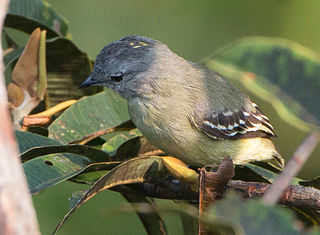
The grey-fronted quail-dove is a species of bird in the family Columbidae. It is endemic to Cuba.

The white-crested elaenia is a species of bird in subfamily Elaeniinae of family Tyrannidae, the tyrant flycatchers. It is found in Bolivia, Chile, Colombia, Ecuador, and Peru.

The Greater Antillean elaenia is a species of bird in subfamily Elaeniinae of family Tyrannidae, the tyrant flycatchers. It is found in the Dominican Republic, Haiti, and Jamaica.

The olivaceous elaenia is a species of bird in subfamily Elaeniinae of family Tyrannidae, the tyrant flycatchers. It is found in Argentina, Brazil, Paraguay, and Uruguay.

The Noronha elaenia is a Vulnerable species of bird in subfamily Elaeniinae of family Tyrannidae, the tyrant flycatchers. It is endemic to the Fernando de Noronha archipelago off the coast of Brazil.

The rufous-crowned elaenia is a species of bird in subfamily Elaeniinae of family Tyrannidae, the tyrant flycatchers. It is found in Brazil, Colombia, French Guiana, Guyana, Suriname, and Venezuela.

The large elaenia is a species of bird in subfamily Elaeniinae of family Tyrannidae, the tyrant flycatchers. It is found in Argentina, Bolivia, Brazil, Colombia, Ecuador, Paraguay, Peru, and Uruguay.

The yellow-crowned elaenia is a species of bird in subfamily Elaeniinae of family Tyrannidae, the tyrant flycatchers. It is found in Brazil, Colombia, Ecuador, French Guiana, Guyana, Peru, Suriname, and Venezuela.

The Pacific elaenia is a species of bird in subfamily Elaeniinae of family Tyrannidae, the tyrant flycatchers. It is found in Ecuador and Peru.

The southern mouse-colored tyrannulet is a species of bird in subfamily Elaeniinae of family Tyrannidae, the tyrant flycatchers. It is found in Argentina, Bolivia, Brazil, Paraguay, Peru, and possibly French Guiana and Suriname.

The Panama tyrannulet or yellow-green tyrannulet is a species of bird in the family Tyrannidae, the tyrant flycatchers. It is endemic to Panama.

The grey-and-white tyrannulet is a species of bird in the family Tyrannidae, the tyrant flycatchers. It is found in Ecuador and Peru.

The southern scrub flycatcher is a species of bird in the family Tyrannidae, the tyrant flycatchers. It is found in Argentina, Bolivia, Brazil, Paraguay, Peru, and Uruguay. Other sources also place it in Guyana, Suriname, as a non-breeding visitor to Colombia, and as a vagrant in Ecuador.

The Peruvian tyrannulet is a species of bird in the family Tyrannidae, the tyrant flycatchers. It is endemic to Peru.

Straneck's tyrannulet, also known as the monte tyrannulet and grey-crowned tyrannulet, is a small species of bird in the family Tyrannidae, the tyrant flycatchers. It is found in Argentina, Bolivia, Brazil, Paraguay, and Uruguay.

The Loja tyrannulet is a species of bird in the family Tyrannidae, the tyrant flycatchers. It is found in Ecuador and Peru.

The small-headed elaenia, also known as the Brazilian elaenia, is a species of bird in subfamily Elaeniinae of family Tyrannidae, the tyrant flycatchers. It is found in Argentina, Brazil, Paraguay, and Uruguay.

The Chilean elaenia is a species of bird in subfamily Elaeniinae of family Tyrannidae, the tyrant flycatchers. It is found in Argentina, Bolivia, Brazil, Chile, Colombia, Paraguay, Peru, and Uruguay.

The Amazonian elaenia or Amazonian grey elaenia is a species of bird in subfamily Elaeniinae of family Tyrannidae, the tyrant flycatchers. It is found in every mainland South American country except Argentina, Chile, Paraguay, and Uruguay, though there is only a single sight record in Suriname.

The Choco elaenia or Choco grey elaenia is a species of bird in subfamily Elaeniinae of family Tyrannidae, the tyrant flycatchers. It is found in Colombia, Ecuador, and Panama.






















